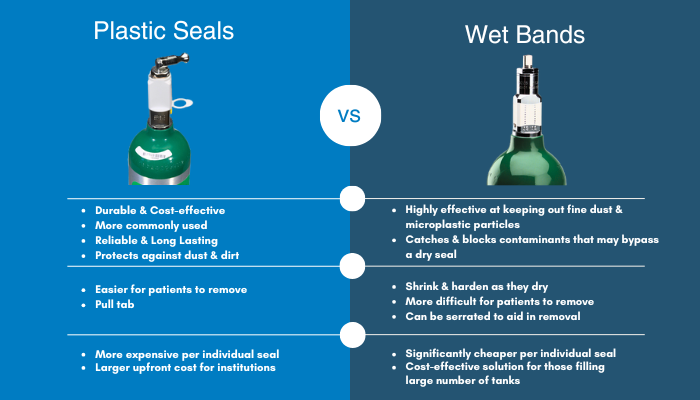PRODUCT CATEGORIES
CLASSES/REGISTRATION
WHAT'S YOUR ROLE?
The Unsung Heroes of Oxygen Tanks: Valve Seals
Why Valve Seals Matter for Oxygen Tanks
When it comes to medical oxygen tanks, we often focus on the obvious: the oxygen itself, the tank’s durability, and the oxygen delivery system. However, one critical component that doesn’t get enough attention is the oxygen tank valve seal. Valve seals are essential for maintaining the integrity and safety of oxygen tanks, acting as a barrier that keeps out harmful contaminants like dust and dirt.
How Valve Seals Keep Dust and Dirt Out
The primary function of a valve seal is to protect the post valve of oxygen tanks from environmental elements. Dust and dirt are more than just a nuisance; they can cause significant problems if they enter the medical oxygen system. Contaminants can interfere with the proper functioning of the valve, leading to potential oxygen leaks, compromised oxygen purity, and even oxygen equipment failure.
Valve seals are designed to create a tight closure, ensuring that the post valve remains clean and operational. By preventing dust and dirt from entering, they help maintain the quality of the oxygen delivery, which is crucial for patient safety and equipment longevity.
Plastic Seals vs. Wet Bands: What’s the Difference?
There are two main types of valve seals used for oxygen tanks: plastic seals and wet bands. Each offers its own benefits depending on specific needs, including ease of use and cost considerations.
Plastic Seals
- Durability and Reliability: Plastic seals are more commonly used and are known for their durability and cost-effectiveness. They provide a reliable, long-lasting barrier that protects the oxygen cylinder post valve from dust, dirt, and other contaminants.
- Ease of Use for Patients: These seals are easier for patients to remove, making them a preferred option in home oxygen therapy systems.
- Cost Consideration: While plastic seals are convenient, they are more expensive per individual seal, making them a larger upfront cost for institutions managing large inventories of oxygen tanks.
Wet Bands
- Enhanced Dust Protection: Wet bands, typically made from flexible materials that are moistened before application, are highly effective at keeping out fine dust and microscopic particles. The moisture in the band helps catch and block smaller contaminants that might bypass a dry seal.
- Challenges for Patients: As wet bands dry, they shrink and harden, which makes them more difficult for patients to remove. This could be problematic for individuals using oxygen tanks for long-term oxygen therapy (LTOT).
- Cost Consideration: Wet bands are significantly cheaper per seal, making them a cost-effective solution for institutions that need to secure a large number of tanks, especially in highly dusty environments.
The Risks of Neglecting Valve Seals
Without a properly functioning oxygen valve seal, the risk of contamination increases dramatically. A damaged or missing seal can allow dirt and debris to infiltrate the system, leading to clogged oxygen valves or damaged components. This not only jeopardizes the effectiveness of the oxygen supply but also poses a risk to the patient’s health.
In extreme cases, a compromised valve seal can result in leaking oxygen tanks, which are both wasteful and potentially dangerous. Regular inspection and replacement of valve seals are essential oxygen safety measures that ensure tanks operate safely and efficiently.
Choosing the Right Valve Seals
Not all valve seals are created equal. When selecting seals for your oxygen cylinders, it’s important to choose high-quality materials that can withstand the rigors of use and environmental exposure. Look for seals that are designed specifically for medical oxygen applications to ensure they meet the necessary safety standards. When selecting seals for your oxygen tanks, it’s important to consider both ease of use and cost:
- Plastic Seals are ideal for situations where patient accessibility is a priority, as they are easier to remove. However, institutions should weigh the higher cost against their durability and user-friendliness.
- Wet Bands are more suitable for environments where cost savings are critical and fine dust protection is essential. While less patient-friendly, they are a practical option for institutions managing high volumes of tanks in challenging conditions.
To ensure the best outcomes, invest in seals designed specifically for medical-grade oxygen tanks and regularly check for wear and tear.
Keep Your Oxygen Tanks in Top Shape: Don’t Overlook Valve Seals
Valve seals may be small, but their role in the safety and reliability of your oxygen tank system is enormous. By keeping dust and dirt out of the oxygen cylinder post valve, they ensure that patients receive the clean, pure oxygen they need. Make valve seal maintenance a priority in your equipment care routine to protect both your investment and the well-being of those who depend on it.
You Might Also Like
Subscribe to our Newsletter
Get the latest regulatory info, accreditation news and exclusive discounts!
 View Cart []
View Cart []

